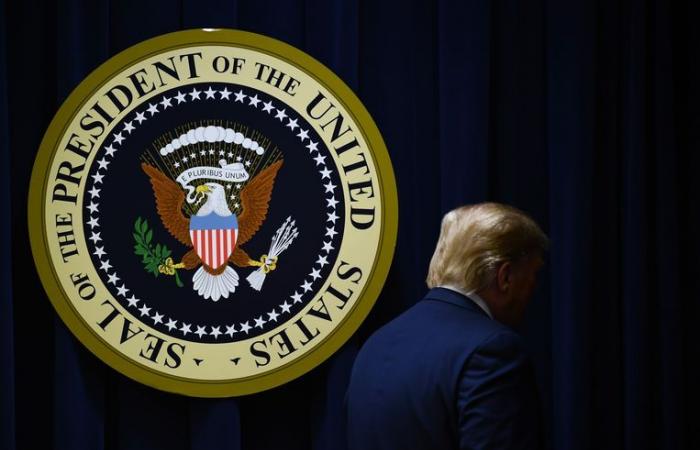Trump’s presidency was a series of abrupt decisions, furious Twitter attacks on his rivals, but also strong economic growth. Until the corona virus struck. In the end, many Americans turned out to be fed up with his anger.
“No shit!” Said Donald Trump in 2011 when Michael Cohen, his lawyer and dirty chores man, showed him a poll showing that as many as a quarter of Republicans saw him as president. ‘Let’s do it. Why not? I’ve had enough of those buildings, golf and television. It would be really cool to be president. ‘
Ultimately, in 2012, Trump did not dare to take on the popular Barack Obama, who he invariably referred to as Barack Hussein Obama, as proof of his theory that the president was actually not a native American.
When he saw an opportunity four years later and threw himself in with the Republicans in the primaries, the party establishment turned their noses up on him. But the boisterous New York real estate mogul dealt surprisingly quickly with a string of established Republican rivals. For a moment, the party leadership considered dumping him after a video surfaced in which Trump made raunchy comments about assaulting women. But Trump got off the scandal unscathed.
His raw, pugnacious language caught on with the segment of the Republican electorate that in an unguarded moment dismissed his Democratic rival Hillary Clinton as “ sad types ”: mostly white voters who felt abandoned, bitter about the clearing of the so-called Rust. Belt, an area in the northeast of the US, and jobs lost abroad. Through those deplorables, Trump found a narrow path to the White House, with a helping hand from Russian hackers who were diligently blackmailing Clinton.
Workshop of the devil
It was clear from Trump’s first day at the White House that this was not going to be a normal presidency. Trump was guided by the motto of his strategist Steve Bannon: politics is not the art of compromise, but the art of conflict. He immediately announced a series of controversial measures, argued with judges who ‘bothered’ him and launched an offensive against ‘unfair’ trading partners such as China, as well as against America’s NATO allies, who he said had also been busy with the US for years. turning it out.
On Twitter, the president launched furious attacks on his political enemies day after day from his bedroom – the ‘workshop of the devil’ according to his chief of staff Reince Priebus. Conflict strategy was also enthusiastically embraced within the White House staff. One after the other was killed, including Bannon, who insulted Trump’s daughter Ivanka. The three generals that Trump had proudly brought in to give his squad a military appearance also had to leave the field. In practice, Mattis, Kelly and McMaster had their hands full to keep the dashing president from making blunders, such as his threat to leave NATO.
But the ‘adults in the room’, as they came to be known, could not prevent Trump from canceling the nuclear deal with Iran (he says the ‘worst deal ever’). The president also soon announced the US’s departure from the “unfair and extremely unfair” Paris climate accord. Trump didn’t make it easy for them either with his thinly disguised fascination with strong leaders, such as Russian President Putin, which often gave US foreign policy a whimsical character.
Herksenhunt
Against the advice of his associates, Trump decided after a few months in the White House to fire FBI Director James Comey for investigating the ties between Trump’s campaign team and the Russians. That turned out to be a major blunder. It gave him an even more difficult client: Special Prosecutor Robert Mueller, who would spend nearly two years digging into the case.
In the end it fizzled out. Mueller concluded that the Russians had helped Trump, but that there was no cooperation. However, according to Mueller, there were numerous indications that Trump had tried to sabotage the investigation. But Trump’s new Attorney General William Barr acquitted his boss: How could Trump be accused of obstruction of justice, if there was no evidence whatsoever for the so-called crime he allegedly tried to cover up?
According to Trump, the outcome of the investigation proved it was one big ‘witch hunt’ that the Democrats had attempted to reverse his election victory through impeachment proceedings against him. But later Trump himself provoked impeachment in Congress when it emerged that he had pressured Ukrainian President Volodymyr Zelenski to investigate his Democratic rival Joe Biden.
The impeachment procedure also fizzled out for Trump. It was probably a strategic blunder on the part of the Democrats: it was clear from the outset that the Republicans, who held the majority in the Senate, would never vote in favor of his impeachment. Only one Republican voted with the Democrats: Mitt Romney. Trump crowed in victory: new evidence that the Democrats wanted to reverse the election results.
Cuckoo Cub
The outcome showed Trump’s hold on the Republican party, which initially didn’t like him. At one time Trump himself had nothing to do with the Republicans, but like a cuckoo pup he has taken over the Republican nest: anyone who criticizes him is inexorably thrown over the edge. At the Republican party convention last summer, the Republicans didn’t even think it necessary to adopt a party program: Trump’s will is enough.
Even his calls to imprison political opponents like Comey, Clinton, Obama, Biden and even the good Mueller did not meet with protests from the Republican Party. Trump’s permanent rage had become the fuel that energized their party. Behind the scenes, however, Trump’s employees had to pull out all the stops to curb the president. White House lawyer Don McGahn even had to explain to him that as president he had no authority to sue his opponents.
Under a favorable light, Trump entered the election year in early 2020. It looked like he was on his way to an easy election victory: he had survived the impeachment and satisfied his constituency by appointing an army of conservative judges, all the way to the Supreme Court. Under him, the US had dealt with the caliphate of the Islamic State terror group in Syria. Trump had also kept his election promise to close the door on immigrants, even though the construction of the ‘beautiful’ wall along the border with Mexico had not been very much done.
Most importantly, the US economy was booming, in part as a result of the tax cuts that Trump had received. Unemployment had fallen dramatically and Wall Street was enjoying its heyday.
Everything was suddenly overshadowed at the end of January by the emergence of the corona virus. Trump tried to avert the epidemic by hiding it. It was nothing more than a flu and would disappear “as if by magic,” he predicted to the Americans. As the epidemic spread, he kept telling Americans that the peak was nearly over, that a vaccine was within reach, or even suggested that bleach could solve the case.
In the meantime, he saw his strongest trump card in the elections, the booming economy, disappear through the drain as a result of the lockdown measures. At the same time, the number of corona deaths continued to rise, to over 200 thousand. When he was struck down by the coronavirus himself last month, it was for many Americans definitive proof of his failing approach to the epidemic.
Trust in Trump was also hit by his response to the Black Lives Matter protests that broke out after George Floyd’s death as a result of police brutality. But here too, Trump chose Bannon’s ‘art of conflict’. Instead of calling for calm, he used the riots and looting that sometimes accompanied the demonstrations to stir things up. This was their fate if they chose Biden, he told the Americans. For law and order they had to be with him.
After he was cured of covid-19 thanks to experimental treatment in the Walter Reed military hospital, he immediately pulled out all the stops. The Americans should ‘not let themselves be dominated’ by the virus, was his message. He had overcome the virus himself, his most dangerous opponent in these elections.
But in the end he had to give up against the calm Biden. Trump once predicted his supporters would get fed up with his “winning, winning, and winning,” but in the end, too many Americans turned out to be fed up with conflict and anger.
These were the details of the news How Trump eventually went down in his own anger for this day. We hope that we have succeeded by giving you the full details and information. To follow all our news, you can subscribe to the alerts system or to one of our different systems to provide you with all that is new.
It is also worth noting that the original news has been published and is available at news1.news and the editorial team at AlKhaleej Today has confirmed it and it has been modified, and it may have been completely transferred or quoted from it and you can read and follow this news from its main source.





